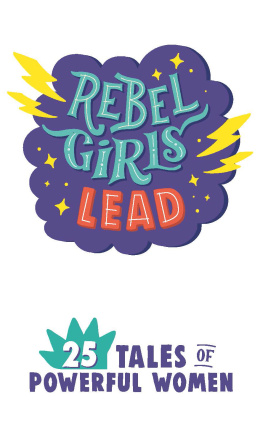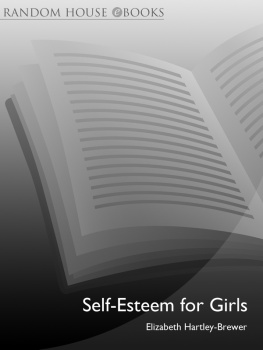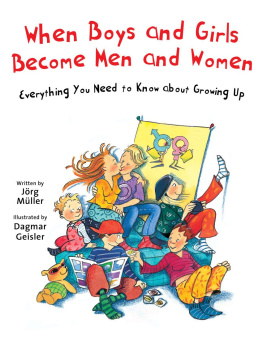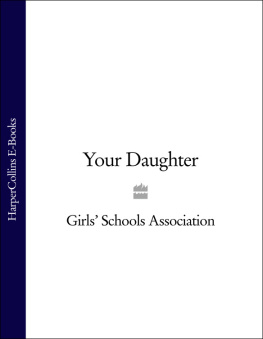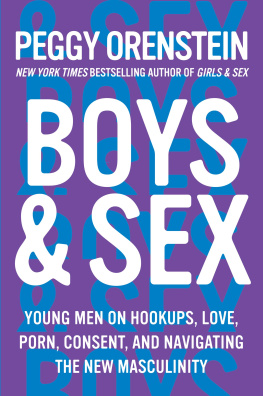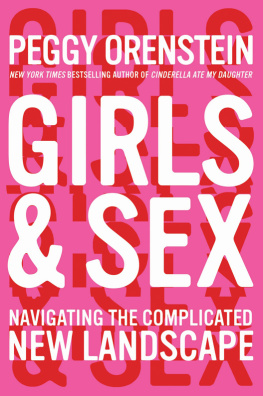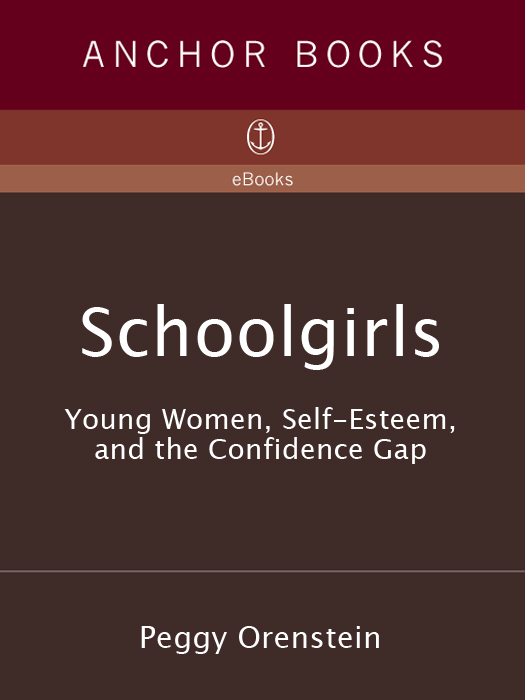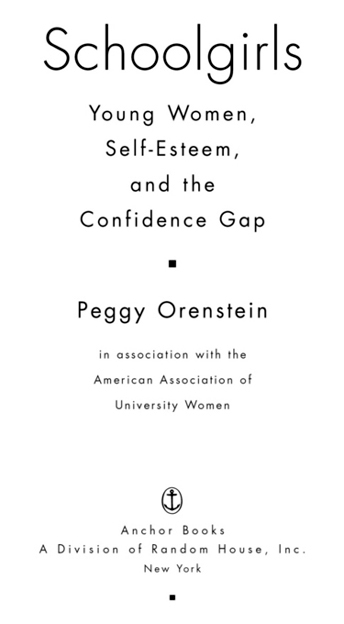PEGGY ORENSTEIN
Schoolgirls
Peggy Orenstein is the author of Flux: Women on Sex, Work, Love, Kids and Life in a Half-Changed World. An award-winning writer and speaker on issues affecting girls and women, she is a regular contributor to The New York Times Magazine, and her work has also appeared in the Los Angeles Times, USA Today, Vogue, Glamour, Mirabella, Details, Elle, Mother Jones, The New Yorker, and other publications. Additionally, she has served as an editor at Esquire, Manhattan inc., 7 Days, and Mother Jones magazines.
ANCHOR BOOK EDITIONS, 1995, 2000
Copyright 1994 by Peggy Orenstein and the American Association of University Women
Preface copyright 2000 by Peggy Orenstein
All rights reserved under International and Pan-American Copyright Conventions. Published in the United States by Anchor Books, a division of Random House, Inc., New York, and simultaneously in Canada by Random House of Canada Limited, Toronto.
Originally published in hardcover in the United States by Doubleday, a division of Random House, Inc., New York, in 1994, and in a previous Anchor Books softcover edition in 1995 in slightly different form.
Anchor Books and colophon are registered trademarks of Random House, Inc.
The Library of Congress has cataloged the Doubleday edition as follows: Orenstein, Peggy.
Schoolgirls : young women, self-esteem, and the confidence gap / by Peggy Orenstein in association with the American Association of University Women.
1st ed. in the United States of America.
p. cm.
Includes bibliographical references.
1. Teenage girlsUnited StatesPsychology. 2. Self-esteem in adolescenceUnited States. 3. Self-perception in adolescenceUnited States. I. American Association of University Women. II. Title.
HQ798.O74 1994
305.235dc20 94-9883
eISBN: 978-0-307-83311-2
www.anchorbooks.com
v3.1
To Steven
Acknowledgments

For me, the writing process has always involved many people: people who gave me opportunity, who broadened my thinking, people who critiqued my manuscript, who offered sustenance and love and, sometimes, told me to stop whining and get back to work. Without themwithout my colleagues, friends, and familythis book could never be.
I owe great debts to my agent, Sandra Dijkstra, and to Sheila Buckmaster, formerly of the AAUW, who saw the potential of this project and forged our alliance; to Doubledays Wendy Goldman; and to Ashley Craddock, Heidi Frieze, and Tina Plaza, who offered invaluable research and translation assistance.
My friends have chewed over my ideas with me endlessly, commented on drafts, and provided more moral support than I could ever repay. In particular, Id like to thank Eva Eilenberg, Ruth Halpern, Peg-bo Edersheim, David Fallek, Neal Karlen, Connie Matthiessen, Sarah Weir, Dvora Honigstein, Catherine Taylor, and Barbara Swaiman (who has been my friend since we were schoolgirls). And, of course, thank you to Beatsy, Mel, Leslie, David, Debbie, and John Orenstein for their love and faith.
In a book such as this, I believe it is especially important to acknowledge a group of people who may or may not remember me: the teachers who made a lasting impact on my life. Thank you to Susan Hanson, the late Betty Ann Long, Richard Rosch, Miriam Kagol, and Oberlins Katherine Linnehan. And to Carrie Jensen, my eighth-grade English teacher at Westwood Junior High, who once told me to send her an autographed copy of my first bookits waiting for you.
Finally, there are three people for whom I reserve special gratitude. My editor, Deb Futter, has given freely of her time, her editorial wisdom, and her friendship. Doug Foster read every word of every draft; his insight and guidance permeate this and all my work. Steven Okazaki has not only been a fine editor, but has endured my tears, shared my triumphs, fed, loved, and even married me during the time I worked on this project. One could not ask for a truer soul mate. This book is dedicated to him, and the standard of equity to which he holds me.
Contents

Preface

A few years afterSchoolgirls was first published, a girl who identified herself only as Fish contacted me via email. Over the next few months we corresponded about her life. She was sixteen and lived in Atlanta, where she went to public school. She hoped some day to become a journalist. She wrote to me about her dreams, her plans, her friends, and her parents. She was pretty confident herself, she told me, but she worried about some of her girlfriends. One hardly ate and kept complaining that she was fat. Another, afraid that she would lose her boyfriend, had begun having sex with him even though she didnt want to and didnt enjoy it. A third who was bright and talented insisted she was stupid. Sometimes, Fish wrote me, she felt like she was living in a chapter of Schoolgirls.
Much has changed in the years since I wrote this book. Theres a whole new section in local bookstores filled with straight-talking guides for teenage girls on how to stay true to themselves as they navigate adolescence. Programs like Girls Incorporated and Girl Scouts foster girls adventurous spirit and intellectual curiosity. The Womens National Soccer Team and the WNBA basketball league have offered an alternative vision of the female body, one thats grounded in strength and utility rather than decoration. At the same time, it would be a mistake to assume that girls are no longer at risk. Like Fishs friends, they continue to face significant, gender-related hurdles as they make the transition to womanhood.
The confidence gap in education hasnt disappeared since I first visited classrooms, but it has changed. With the help of grass roots programs, and federal attention, the difference between boys and girls test scores in math and science has narrowed. But a new trend has emerged: few girls are taking computer courses, and those who do tend to enroll in data entry (the millennial version of typing) classes, while boys take advanced programming. What is it about the way we teach computer science that is discouraging girls? Its an urgent question: in todays technology-driven ecomony, a digital divide could have a disastrous effect on girls futures.
As Ive criss-crossed the country, speaking to parents, teachers, college students, and young girls, Ive become more convinced than ever that girls bodies have become the battleground for their conflicts. Hating ones body, sometimes to the point of starvation, remains a tragic rite of passage for young women: among white girls in particular, appearance remains the most important determinant of teenage girls self-worth. Meanwhile, girls are under tremendous pressure to become sexual at an inappropriately young age. How do we teach them that they have the right to say no? How do we teach them that when they say yes, it should be on their own termsnot to please someone else or to keep him from walking out the door?



